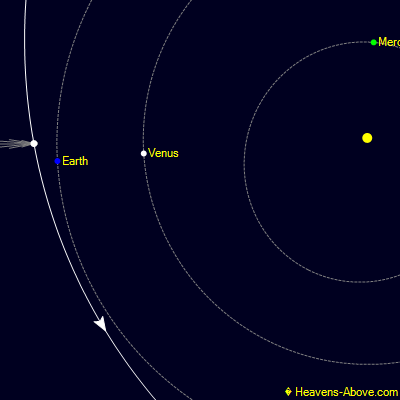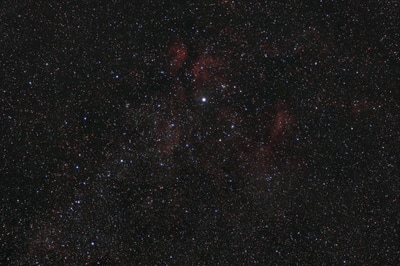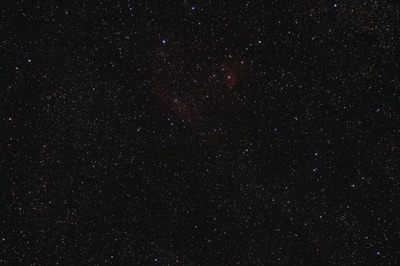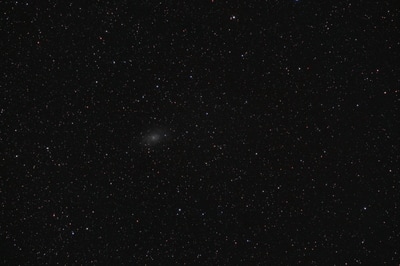|
Sometimes "CSI enhance" really works, just not with blurry CCTV footage of hardened criminals. The biggest obstacle to taking clear images of the Moon and planets is Earth's turbulent atmosphere, which causes a heat -haze like effect. Astronomers use a technique called lucky imaging to overcome this. A video is taken of the target and stacking software used to identify and combine the sharpest frames. This makes it possible to recover detail impossible to see in the source video or at the eyepiece.
The image above was taken with a 12" dobsonian telescope with a 2x barlow lens, giving an effective focal length of 3,000mm. For comparison, a very large telephoto lens might have a focal length of 600mm, one fifth the magnification. AutoStakkert 3.1.4 was used to analyse and stack the source video. As well as the atmospheric turbulence it was able to cope with some uneven motion from the telescope as it tracked the target crater imperfectly. So why doesn't technique this work with CCTV footage? If the subject stays quite still it is possible to recover a bit more detail by combining frames, but this won't work if they are moving. Also, the quality of any image is constrained by the size and quality of the optics, and the image sensor. A small lens and cheap sensor produces images with limited resolution even under the best conditions. Copernicus crater, on the near side of the Moon, is 93km across and 3.8km deep - not quite big enough to fit the county of Cornwall inside it. It's a relatively young crater, thought to have excavated by an impact some 800 million years ago. It's surrounded by a visible system of rays pointing outwards, lighter materiel that was ejected and that still lies on the Moon's surface. The best place to photograph it is from Lunar orbit rather than the surface of the Earth, 360,000km away, but that's not an option for most astronomers. These two spectacular images were taken during the Apollo 12 mission.
0 Comments
If you're prepared to forego some sleep, May can be a good time to view the Milky Way from the UK.
The 40-minute timelapse shows the galactic centre, in the constellation Sagittarius, rising to the South. It's the brightest region of the Milky Way due to the concentration of stars. The glow on the left is from the city of Plymouth 15 miles away.
The panoramic image was stitched together from about a dozen overlapping frames, from North on the left to South on the right. The centre of our galaxy is to the right while to the left we're looking towards its outer regions.
The naked eye view is both more and less impressive than the panorama. The image shows more detail and colour but can't convey the immense scale of our galaxy reaching across the sky. Observation and astrophotography complement each other.
The Milky Way is a spiral galaxy, a disc-like structure with a central bulge of stars. Our solar system resides in the Orion-Cygnus arm.
Notice how the constellations match up with those visible in the panorama. From our vantage point we have a limited view of the Milky Way as its dust lanes block our view, thanks to instruments like the Hubble space telescope we have a better idea of the shape of many distant galaxies than our own. The image above is an artist's representation but it's based on real data. The major features have been mapped out from radio signals and infra-red light, which can travel through the dust.
The dust lanes can be seen in the panorama, the most prominent one the Great Rift which runs from Cygnus to Sagittarius. Visually, it splits the Milky Way in two. There are just as many stars in this region but they are hidden from view.
We can view different sectors of the galaxy over the course of the year as the Earth orbits the Sun. From the UK the southern constellations between Norma and Puppis never rise above the horizon but the others - Canis Major to Scorpius - can be seen. The galactic centre is best seen in May, August and September (in June and July the nights are short and the sky never gets fully dark as the upper layers of the atmosphere are it up by the Sun). Canis Major, Monoceros and Orion are best viewed in the Winter.
Visible light never tells the whole story. The human eye is only sensitive to a small window in the electromagnetic spectrum. We can't perceive light that has a shorter wavelength than violet or a longer wavelength than red.  Credit: Wikimedia user D-Kuru Credit: Wikimedia user D-Kuru Infra-red light was discovered by an astronomer, William Herschel, better known for discovering the planet Uranus with his home-built telescope. He simply used a prism, a sunbeam and a thermometer. The prism splits the Sun's white light into its component colours as red light is refracted (or bent) less then blue light. When a thermometer is placed in the coloured beam its temperature rises, as the dispersed sunlight heats it. But Herschel was shocked to find that when he placed the thermometer just to the right of the red light the temperature went up even more. He concluded that the Sun was emitting a form of invisible light which we now call infra-red, literally "below red". This turned out to be a far more important discovery than finding a new planet. (It was also something of an accident, William moved the thermometer out of the beam to measure the ambient air temperature, but he deserves full credit for noticing and solving the puzzle.) Infra-red detection is somewhat misleadingly referred to as 'heat vision'. In fact, all objects emit light, it's just that objects at everyday temperatures radiate mostly infra-red. It's odd to think that we glow in infra-red light. Hotter objects shine in visible light, you can see this by turning on an electric hob. As it warms up it starts to glow a dull red, as peak emission moves up the electromagnetic spectrum from infra-red towards red. Our Sun, with a surface temperature of almost 6,000°C, shines most brightly in green light but we perceive it as white because blue and red light is also produced. Objects don't emit a single wavelength (or colour) of light but a range, the Sun also produces infra-red and ultra-violet light. There is a relationship between temperature and energy, higher frequency light-waves carry more energy so require higher temperatures to produce. Very hot objects emit x-rays, while cold ones produce microwaves or radio waves. This phenomenon is somewhat confusingly called 'black-body radiation', it matters to us because it's how the Sun warms our planet. It's also useful to blacksmiths, who use the colour of the heated metal to judge its temperature. Above are two images of NGC 1499, the California Nebula. The monochrome image on the left shows glowing hydrogen (actually a deep red colour, but the mono image shows more detail) and was taken at Caradon Observatory. The image on the right is a bi-colour composite of visible and infra-red light. Glowing hydrogen is shown as orange while 'warm' interstellar dust is blue. ('Warm', that is, compared to the near-void of space. The dust is at a temperature of somewhere between -170°C and -200°C.) Regions that emit both Hα and IR light are white.
The infra-red data reveals a much larger structure than can be seen in visible light. The blue patch on the left of the nebula appears be heated by stellar winds from the star Xi Persei, which is responsible for lighting up the nebula. The glowing hydrogen is a relatively thin skin on a large cloud of gas and dust. Concentrations of gas and dust block the UV light from XI Persei, providing shade. The IR data has been raided from one of NASA's space telescopes, the Wide-field infrared Survey Explorer (WISE). WISE images are freely available for download but must be credited. It's surprising just how far some deep sky objects stretch across the sky. This composite shows a deeper exposure aligned over a wide-angle image of the Caradon Observatory site. The outer Milky Way runs from upper left to lower right, from Gemini to Cassiopeia. Visible above the trees is the red smear of NGC 1499, the California Nebula, to scale with the foreground image. It covers some 3 degrees of the sky, six full Moons across. While invisible to the naked eye it's not that far out of sight, making a challenging binocular target. However, in long-exposure photographs it's one of the brightest nebulae in the sky. A closer view shows its structure, glowing red from ionised hydrogen with hints of blue from glowing oxygen giving it a pink hue. Dark features are concentrations of dust, often sites of star formation. It's a vista sculpted by natural processes - stellar winds and radiation pressure from bright stars, and gravity.
Xi Persei is a runaway star, ejected from its birthplace either by a close encounter with another star or the supernova of a companion. A chance encounter has brought it close to a molecular cloud, making the California Nebula visible. The plane of the Milky Way is littered with these concentrations of gas and dust, largely invisible in the visible spectrum but detectable by radio and infra-red telescopes. The nebula is just an optically bright feature of a much larger complex. If Xi Persei had been launched in another direction it might well have painted, and to a degree sculpted, an entirely different deep sky object. The monochrome image above was taken using a short telephoto lens on the 26th March and blended into a colour image taken previously. Imaging it with a telescope usually requires shooting separate panes to stitch together in a mosaic, as it will not fit within the field of view. This spectacular 103 hour effort by Sara Wager shows the nebula in intricate detail and is best viewed on a large high-resolution monitor.
Kit lenses, commonly bundled with DSLR cameras, offer a natural entry point into astrophotography due to availability and their wide field of view, allowing reasonable exposure times from a fixed tripod. The major difficulties for first time users are finding the correct camera settings and focusing on infinity. This guide offers a few tips based on my own experiences and blunders. This was one of my first attempts at shooting the Milky Way, taken on holiday in Menorca. I didn’t have a tripod with me so I simply laid the camera down on the patio, pointing straight up. It’s a 30 second exposure at 18mm focal length, giving the widest field of view. To capture as much light as possible the camera iris was opened fully, giving a focal ratio of f3.5.
Camera and Lens Settings It’s worth experimenting with these settings before heading out, to help avoid the frustration of fighting the camera in the dark. Aperture When shooting from a fixed tripod it’s important to gather as much light as possible. Typically this means shooting with the lens wide open by selecting the lowest aperture setting available. ... Here's a quick animation from the night of 24th/25th March showing the movement of Comet 41P against the background stars. Each frame is a 2 minute exposure taken with a 135mm lens, the time-lapse is two hours long. On the 24th March it was visible in the bowl of The Big Dipper, or business end of The Plough if you prefer. The bright stars of this famous asterism are just out of frame. Over the next few days it moved into the neighbouring constellation of Draco. Comet 41P goes by the name of Tuttle–Giacobini–Kresák which is a bit of a mouthful. This is because comets are typically named after their discoverers, 41P was independently found in 1858, 1907 and 1951. It is a short period comet which approaches the Sun every 50 years or so and is thought to have a nucleus about a mile across. The comet has a circular appearance rather than showing the classic cometary tail because of the viewing angle.
... Practical astronomy with an almost-seven year old?  Spent some time with nephew-nearly-seven over Christmas and - despite the lure of lego ninjas and talking dinosaurs - he was quite happy to join me outside on a clear and frosty night. I started off by showing him a few landmarks of the sky - the Milky Way, most prominent stars and recognisable constellations - using a laser pointer to trace out their shapes. (After first explaining the importance of checking for aircraft, to avoid dazzling them. He certainly made a conscientious air traffic controller, for the rest of the evening I couldn't go near the the laser without a warning, including for planes fifty miles away and in the other direction.) Resting on the Pole star I tried to explain how the stars appear to rotate around it, as shown in the time-lapse video below. Video by James Castelli, Cherry Springs, Pennsylvania - Aug 2008 Next we had a go at astrophotography, I set up a motorised tracking mount and attached a camera with a wide lens. I pointed the camera in roughly the right direction and disengaged the clutches so he could gently nudge it on to target. After a couple of attempts he got this shot of the Milky Way with a 2 minute exposure.
When thinking of deep sky objects (DSOs) - distant nebulae and star clusters within the Milky Way and even more distant galaxies - it's natural to assume that a large telescope is required to view them. In many cases this is true, where the vast sizes of these objects is trumped by the even greater distances to them. However, there are a number of DSOs - relative neighbours in cosmic terms - that occupy surprisingly large slices of our sky. The gallery below shows a number of fairly bright DSOs along with the Moon, to show their relative apparent sizes.
The montage shows the progression of the September 2015 lunar eclipse over a period of about two hours, as Earth's curved shadow passes across it. Unusually, this eclipse coincided with a so-called supermoon, where the full moon is at the closest point in its orbit and appears slightly larger to the eye - such an event will not occur again until 2033. At totality the Moon is still visible as some sunlight still reaches it by passing through the Earth's atmosphere. However, it appears much dimmer and redder than normal - at a second the final exposure in the sequence is 1,000 times longer than the first. The deep red colour is caused by the same phenomena that makes our sky blue - our atmosphere scatters blue light more readily so that more red light reaches the Moon's surface, and is reflected back to Earth.
Taken by Ken Bennett, with the aid of a 5" refracting telescope, DSLR camera and some choice Cornish cursing-words. |
Archives
May 2020
Categories
All
|






































 RSS Feed
RSS Feed